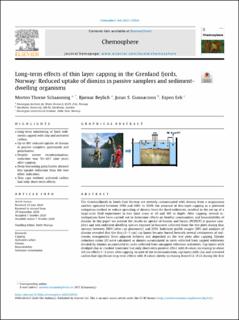| dc.contributor.author | Schaanning, Morten Thorne | |
| dc.contributor.author | Beylich, Bjørnar | |
| dc.contributor.author | Gunnarsson, Jonas S | |
| dc.contributor.author | Eek, Espen | |
| dc.date.accessioned | 2021-05-27T11:47:59Z | |
| dc.date.available | 2021-05-27T11:47:59Z | |
| dc.date.created | 2020-10-10T18:41:21Z | |
| dc.date.issued | 2020 | |
| dc.identifier.citation | Chemosphere. 2020, 264, 128544. | en_US |
| dc.identifier.issn | 0045-6535 | |
| dc.identifier.uri | https://hdl.handle.net/11250/2756658 | |
| dc.description.abstract | The Grenlandfjords in South East Norway are severely contaminated with dioxins from a magnesium smelter operated between 1950 and 2001. In 2009, the proposal of thin-layer capping as a potential mitigation method to reduce spreading of dioxins from the fjord bottom, resulted in the set-up of a large-scale field experiment in two fjord areas at 30 and 100 m depth. After capping, several investigations have been carried out to determine effects on benthic communities and bioavailability of dioxins. In this paper we present the results on uptake of dioxins and furans (PCDD/F) in passive samplers and two sediment-dwelling species exposed in boxcores collected from the test plots during four surveys between 2009 (after cap placement) and 2018. Sediment profile images (SPI) and analyses of dioxins revealed that the thin (1-5 cm) cap layers became buried beneath several centimeters of sediments resuspended from adjacent bottoms and deposited on the test plots after capping. Uptake reduction ratios (R) were calculated as dioxins accumulated in cores collected from capped sediments divided by dioxins accumulated in cores collected from uncapped reference sediments. Cap layers with dredged clay or crushed limestone had only short-term positive effect with R-values increasing to about 1.0 (no effect) 1-4 years after capping. In spite of the recontamination, cap layers with clay and activated carbon had significant long-term effects with R-values slowly increasing from 0.12-0.33 during the first three years to 0.39-0.46 in 2018, showing 54-88 % reduced uptake of dioxins (PCDD/F-TE) throughout the nine years investigation period. | en_US |
| dc.language.iso | eng | en_US |
| dc.rights | Navngivelse 4.0 Internasjonal | * |
| dc.rights.uri | http://creativecommons.org/licenses/by/4.0/deed.no | * |
| dc.title | Long-term effects of thin layer capping in the Grenland fjords, Norway: Reduced uptake of dioxins in passive samplers and sediment-dwelling organisms | en_US |
| dc.type | Peer reviewed | en_US |
| dc.type | Journal article | en_US |
| dc.description.version | publishedVersion | en_US |
| dc.rights.holder | © 2020 The Authors | en_US |
| dc.source.pagenumber | 11 | en_US |
| dc.source.volume | 264 | en_US |
| dc.source.journal | Chemosphere | en_US |
| dc.identifier.doi | 10.1016/j.chemosphere.2020.128544 | |
| dc.identifier.cristin | 1838670 | |
| dc.source.articlenumber | 128544 | en_US |
| cristin.ispublished | true | |
| cristin.fulltext | original | |
| cristin.qualitycode | 1 | |

